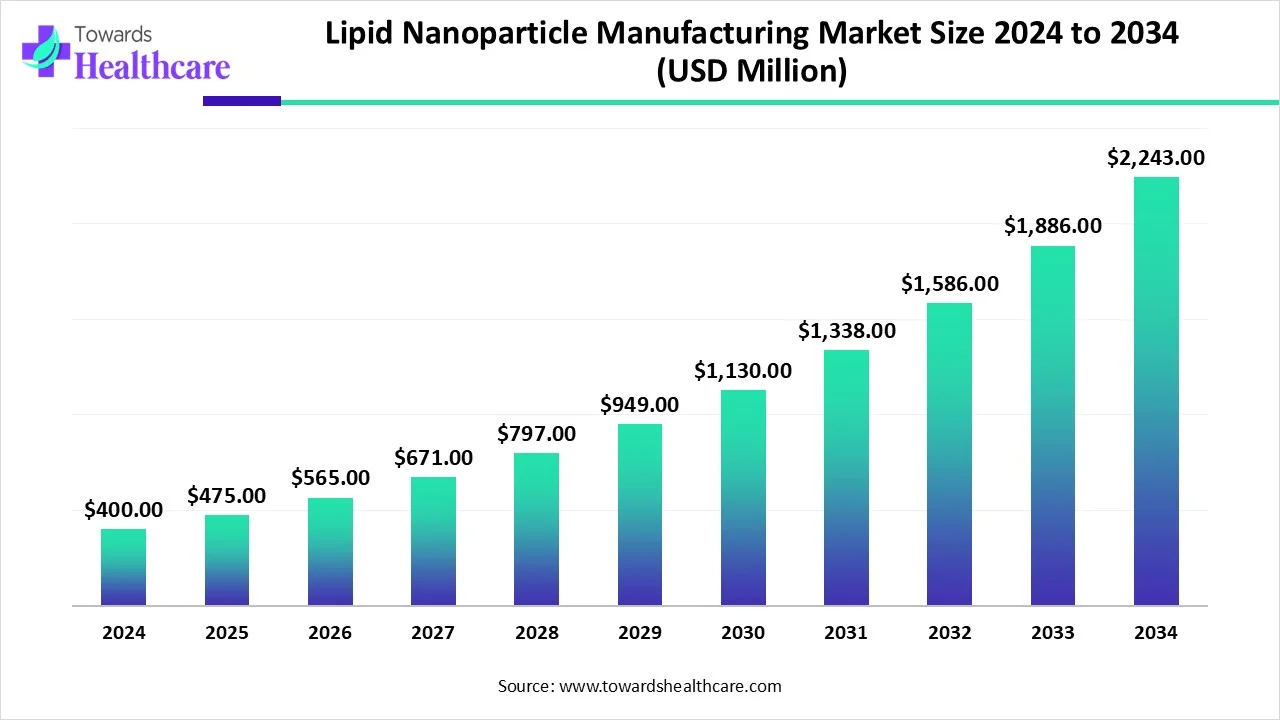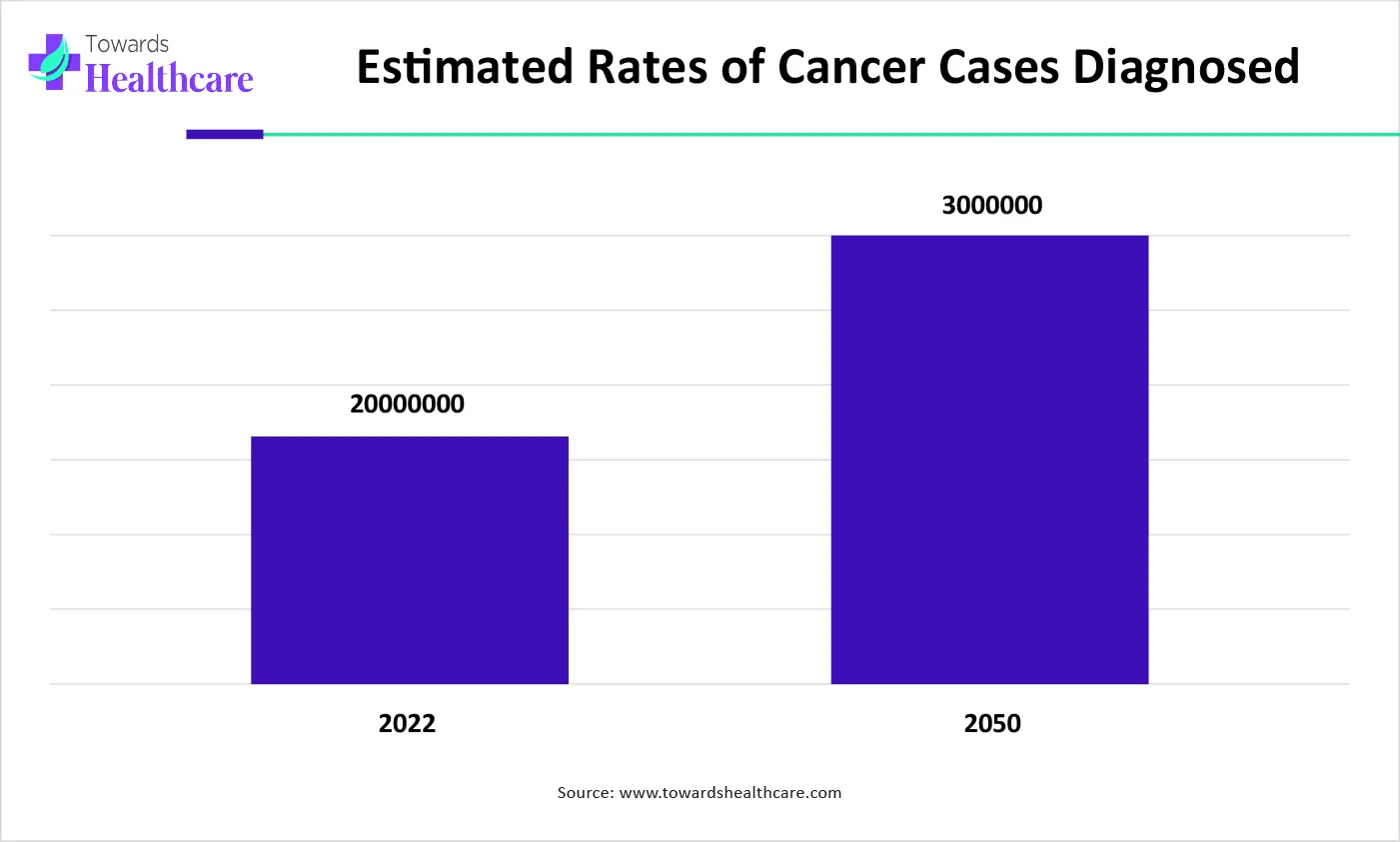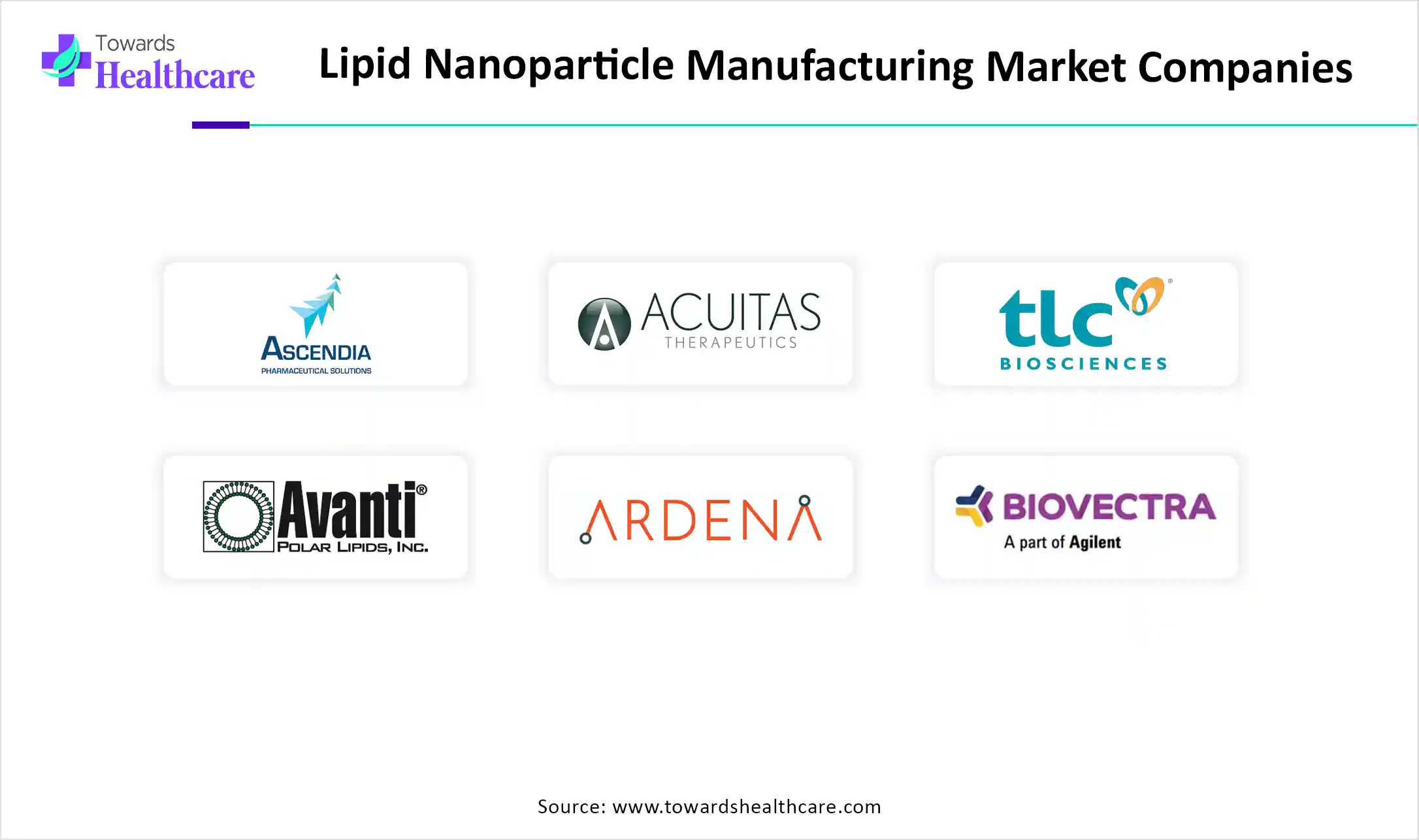November 2025

The global lipid nanoparticle manufacturing market size is calculated at USD 400 in 2024, grew to USD 475 million in 2025, and is projected to reach around USD 2243 million by 2034. The market is expanding at a CAGR of 18.9% between 2025 and 2034.

| Metric | Details |
| Market Size in 2024 | USD 400 Million |
| Projected Market Size in 2034 | USD 2243 Million |
| CAGR (2025 - 2034) | 18.9% |
| Leading Region | North America |
| Market Segmentation | Type of Lipid Nanoparticle, Type of Molecule Delivered, Company Size, Therapeutic Area, Type of End-user, By Region |
| Top Key Players |
Ascendia Pharmaceuticals, Acuitas Therapeutics, TLC Biosciences, Avanti Polar Lipids, Ardena, Creative Biolabs, BIOVECTRA, Emergent BioSolutions, CordenPharma, Evonik, Curia, EUROAPI, Fresenius Kabi, FormuMax Scientific, leon-nanodrugs, Fujifilm, Merck kgaa, Integrated Nanotherapeutics, Pantherna Therapeutics, Matinas BioPharma, Precision NanoSystems |
Lipid nanoparticles have several advantages in drug development as they can transport poorly water-soluble drugs as well as oligonucleotides, and also have high biodegradability and biocompatibility. Similarly, by encapsulation, it can be used for target-specific action in cancer treatment or any other disease. The manufacturing process of LNP is complex due to which means it must be controlled for the production of improved and optimized quality of the medications. Thus, the use of Process Analytical Technology (PAT) and product monitoring is increasing their importance during the manufacturing process. The use of PAT can provide monitoring of the size of the nanoparticles as well as the product characterization, enhancing the LNP manufacturing process.
The lipid nanoparticle can be used in the treatment of protein replacement, vaccine development, and gene therapy, as they are nanocarriers. But there are certain limitations in LNP, such as low delivery efficiency, immune activation, and toxicity. Thus, to tackle these limitations, artificial intelligence can be used. It helps in the optimization of LNP formulation, its design, as well as in the prediction of performance and properties. It also helps in improving the selectivity and specificity of LNP. Furthermore, model performance can be increased by using contrastive and generative pretraining methods using AI to improve the safety and efficiency of LNP formulation. The LNP targeted conjugation can also be developed using AI modelling of antibodies.
Rising Occurrence of Diseases
Due to increasing occurrences of diseases such as genetic diseases, cancer, infections, etc., the demand for effective treatment options is rising. Therefore, with the help of lipid nanoparticles, various treatment options can be developed. This, in turn, increases their demand for providing targeted drug delivery. Moreover, different types of vaccines are also being developed for various infections. These LNPs can also be used in gene therapies. Hence, it enhances patient outcomes, increasing their adherence to the treatment. Thus, it drives the lipid nanoparticle manufacturing market growth.

The graph represents a comparison between the estimated rates of cancer cases diagnosed in the year of 2022 and 2050. It indicates that there will be a rise in cancer cases, which will lead to an increased demand for LNPs treatment options. Thus, this in turn will ultimately promote the market growth.
High Prices
The specialized equipment, as well as the advanced technologies, are costly, due to which various industries and startups cannot afford them. Similarly, the ingredients required for formulating LNP are also expensive. This, in turn, increases the production cost. Thus, all these factors make the LNPs expensive, which, in turn, affects the acceptance rate in the population.
Increasing Nucleic Acid-Based Treatment Options
Lipid nanoparticles act as carriers thus can be used to deliver various unstable drugs. This has increased its use in the development of new formulations for the effective delivery of nucleic acids such as DNA and RNA. This enhanced the treatment options for gene therapies as well as vaccines. Furthermore, cancer, infectious diseases, rare genetic diseases, and autoimmune conditions also utilize LNP with nucleic acid for their effective treatments. This promotes the lipid nanoparticle manufacturing market growth.
For instance,
By lipid nanoparticle type, the solid lipid nanoparticle segment dominated the market in 2024. This segment dominated because the solid lipid nanoparticles provided controlled as well as sustained drug release, which reduced the dosing frequency, enhancing the treatment adherence. Furthermore, the increased stability also contributed to the market growth.
By lipid nanoparticle type, the nanostructured lipid carriers segment is estimated to be the fastest-growing at a notable CAGR during the forecast period. The loading capacity of nanostructured lipid carriers is greater, which can incorporate a large dose of drugs. It can also be used in various disease treatments.
By molecule delivered type, the nucleic acids segment dominated the market in 2024. This is due to nucleic acid-based treatments were used in various diseases as well as in the development of vaccines. This also increased their use in various genetic disease treatment
By molecule delivered type, the small molecules segment is anticipated to be the fastest-growing during the forecast period. They offer the effective delivery of poorly soluble as well as unstable drugs. Furthermore, it also provides controlled release, which contributes to the lipid nanoparticle manufacturing market growth.
By company size type, the very large and large companies segment dominated the market in 2024. This segment dominated as very large and large companies consisted of advanced equipment as well as technologies. This, in turn, enhanced the manufacturing process of LNPs.
By company size type, the mid-sized companies segment is predicted to be the fastest-growing during the forecast period. The mid-sized companies are increasing their research for the development of new LNPs treatment options. Furthermore, they are also collaborating to enhance the production rates.
By therapeutic area type, the infectious diseases segment dominated the global lipid nanoparticle manufacturing market in 2024. The segmental growth is attributed to the rising prevalence of infectious diseases and the growing need for advanced drug delivery systems for infectious diseases. In treating infectious diseases, various vaccines as well as treatment options have been developed using LNPs. This contributed to the market growth.
By therapeutic area type, the oncological disorders segment is expected to be the fastest-growing during the forecast period. The oncological disorders are rising, due to which the use of LNP is increasing. Furthermore, it provides targeted action that reduces the side effects, enhancing its use.
By end user type, the pharmaceutical and biotechnology companies segment dominated the global lipid nanoparticle manufacturing market in 2024. The pharmaceutical and biotechnology companies consist of advanced technologies and skilled personnel, which have improved the production as well as the quality of LNP, raising its distribution rates. Moreover, new developments also contributed to the same.
By end user type, the academic and research institutes segment is anticipated to be the fastest-growing during the forecast period. The academic and research institutes are focusing on the new innovation of LNPs treatment options. Furthermore, the rising collaborations are also promoting the market growth.
North America dominated the lipid nanoparticle manufacturing market in 2024. North America consists of well-developed industries which increased the manufacturing of lipid nanoparticles as medications for various diseases. Furthermore, new innovations also contributed to the market growth.
The industries in the U.S. have increased the development process of lipid nanoparticles due to their enhanced effectiveness. At the same time, the presence of well-equipped manufacturing instruments helps in rapid production, enhancing the manufacturing process.
The industries with advanced technologies and equipment are improving the development process as well as the quality of LNP. Moreover, the increasing collaborations are also enhancing the new developments of LNPs.
Asia Pacific is estimated to host a significantly growing lipid nanoparticle manufacturing market during the forecast period. Asia Pacific is experiencing rapid industrialization. These industries are adopting various technological advancements, enhancing the overall development process of LNPs. At the same time, the government is also supporting the treatment by making it affordable, which in turn is promoting the market growth.
The industries in China consist of skilled personnel, and they are also utilizing various technological advancements to improve the manufacturing process of LNPs. Furthermore, the funding provided by the government also enhances the manufacturing and research of lipid nanoparticles.
The Indian industries are adopting a variety of technologies for the effective development and management of them. This is increasing the production of LNP. At the same time, generic drugs are being made available with the help of the government.
Europe is expected to show lucrative growth in the lipid nanoparticle manufacturing market during the forecast period. Various industries and institutes in Europe are focusing on the development of new LNP treatment options. This, in turn, is increasing the number of research studies carried out in industries as well as institutes, which enhances the market growth.
The enhancing research studies for the development of new strategies in treating different diseases are driving the industries as well as academic institutes. These are further funded by the government, which in turn increases the interest, causing improved development in the research.
Due to the advantages of LNP, the research conducted in the institutes and industries is increasing. Furthermore, they are collaborating to develop new treatment options for rising diseases, which is also supported by the government.
The Middle East & Africa are expected to grow at a notable CAGR in the lipid nanoparticle manufacturing market in the foreseeable future. The growing research and development activities lead to the development of novel drug delivery systems. The increasing investments and collaborations among academic researchers and key players promote the market. The rapidly expanding pharmaceutical and healthcare sectors and the increasing number of startups contribute to market growth.
The Saudi Food & Drug Authority (SFDA) recently approved a clinical study, “A Global Phase 1/2 Open-Label Dose-Optimization Study to Evaluate the Safety and Pharmacokinetics of the Biologic Treatment (mRNA-3927) in Participants with Propionic Acidemia”. The government formed the “Health Sector Transformation Program”, a key initiative of Saudi Arabia 2030, to establish the Kingdom as a prominent regional hub for research, development, and health innovation. (Source: Saudi Food and Drug Authority)
In January 2025, Afrigen Biologics announced that develop the first-ever mRNA-based vaccine against Rift Valley fever, a mosquito-borne disease affecting countries across Africa and the Middle East. The CEPI (Coalition for Epidemic Preparedness Innovations) provided funding of $6.2 million/ 116 million. (Source: CEPI)

Arcturus Therapeutics is a nucleic acid medicines company focused on developing RNA therapeutics to treat rare diseases. The company offers LUNAR lipid-mediated delivery and STARR mRNA technology. The fourth-quarter 2024 revenue was $22.8 million, and the full-year 2024 revenue was $138.38 million. (Source: Arcturus Therapeutics)
Generation Bio is a biotech company that aims to lead the future of T-cell targeted therapeutics. The company offers cell-targeted lipid nanoparticle (ctLNP), a breakthrough technology for targeted delivery. The fourth-quarter 2024 revenue was $4.18 million, and that of the full year 2024 was $19.89 million, compared to $5.9 million in 2023. (Source: Biospace)
By Lipid Nanoparticle
By Molecule Delivered
By Company Size
By Therapeutic Area
By End-user
By Region
According to market projections, the global pharmaceutical inspection machines market, valued at USD 0.96 bi...
Around the world, the sex-based drug development market is driven by the rising approaches to sex-based differ...
November 2025
November 2025
November 2025
November 2025